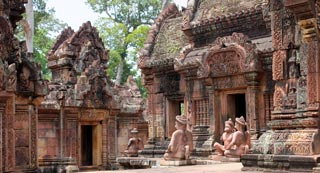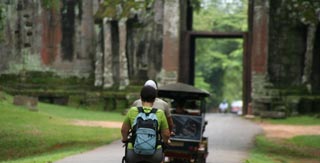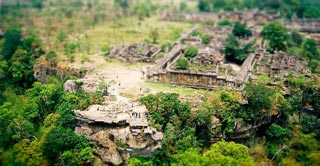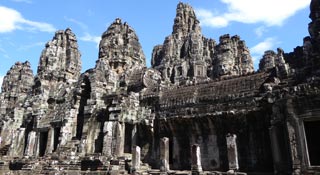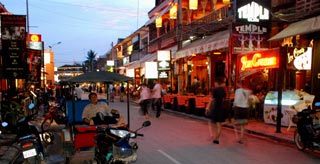Angkor Small & Big Circuits
Angkor City
When talking about the temples around Angkor, you will often hear them referred to as being on the small or big circuit (also petite or grande). These two circuits cover most of the temples and structures located at or relatively close to Angkor Wat and Angkor Thom. You might not necessarily stick to all the temples on 1 circuit on a given day, but it does help give an idea of what temples are good to see together. The below is a high-level overview of all the notable temples and structures on the two circuits. We created half, 1, 2 and 3 day tours found in the highlights section, be sure to take a look. 1 - Angkor Wat Built for King Suravaraman II in the early 12th century as his capital city. The world's largest religious building was constructed by thousands of artisans, workers and slaves, and it took nearly 40 years to complete. Every surface is richly decorated with scenes of legends, wars and everyday life, enhanced by carvings of 2,000 apsaras (heavenly nymphs). It is built to represent Mt Meru, home of the Hindu gods. The monuments of Angkor are great achievements of the ancient world. Since 1992 the whole temple complex at Angkor has been listed by the World Heritage Convention. 2 - Phnom Bakheng Located on the hill near Angkor Thom and was built by King Yasovaramn as the centrepiece of his new capital. Phnom Bakheng is the first mountain-style temple built there and also represents Mt Meru. Before it had a giant seated Buddha on the top platform but it was not completed and collapsed under its own weight. The temple is popular today mainly for its 360-degree panoramic view, from where you can see the Tonle Sap and Angkor Wat, particularly at sunset. 3 - Baksei Chamkrong Is a small Hindu temple erected by King Harshavaraman I. Situated on the left side of the way from Angkor Wat to Angkor Thom and was dedicated to the Hindu deity Shiva, built in memory of the King's parents. Initially, golden statues of Shiva and his spouse-deity Devi decorated the entrance of the pyramid-shaped temple. 4 - South Gate of Angkor The South Gate is one of the five gateways into the ancient Khmer city of Angkor Thom. The most visited of the five Angkor Thom gates as it is nearest to Angkor Wat. A bridge goes across what is now a dry moat into the gate. Busy around sunset with traffic. 5 - Angkor Thom The last and most enduring capital city of the Khmer Empire. The fortified city was built by Angkor's greatest King Jayavarman VII (1181-1219). It was the centre of his massive building program. It is believed to have sustained a population of 80,000-150,000 and governed over 1 million people. Angkor Thom is enclosed by 'jayagan' (spare wall). The city has five large gates. The main path leads through the Royal Enclosure, Phimeanakas, the Terrace of Elephants, Preah Paliley, North and South Kleangs. 5a - Preah Paliley Built by King Jayavarman VII in the 12th century and dedicated to Buddha. In front of the temple, there is a statue of Buddha and the Cambodians pray there often. Preah Paliley is also a meeting place for monks and nuns. The temple has the shape of a chimney. It's a nice walk along the forest path from Preah Paliley to Phimeanakas past the Royal Palace northern wall. 5b - Phimeanakas & Royal Palace To the north of Bayon is a Hindu temple, built at the end of the 10th century during the reign of Rajendravaramna and rebuilt by Suravaraman II as a sandstone pyramid, another representation of Mt Meru. Located in the middle of the old Royal Palace Area and is the tallest scalable temple. Not much is left of the old Royal Palace, just the Northern wall and two sandstone pools next to it, now used as swimming pools by the local kids. The legend says that a golden tower crowned the temple and a nine-headed serpent which would transform into a woman lived there. The kings of Angkor were required to make love to her every night to protect the kingdom from disaster. 5c - Terrace of Elephants Built at the end of the 12th century and used by King Jayavarman VII to view his victorious returning army. The 350m long terrace is located north of Bayon and was used as a large viewing stand for public ceremonies. The middle section of the retaining wall is decorated with life-sized Garuda and lions. On both sides, you can see parts of the famous parade of elephants together with their Khmer mahouts (master). 5d - Terrace of the Leper King A terrace wall just north of the Elephant Terrace with deeply carved nagas, demons and other mythological beings. The Leper King name is after a seated statue which was moved to the National Museum in Phnom Penh that had heavy discolouration and moss growing on it which looked like a person with leprosy. 5e - Preah Pithu A group of five temples are north-east of Bayon in front of Tep Pranam. Although the temples are situated next to each other, only two were built in same period. The last temple to be built is a Buddhist temple and the other Hindu. They are in pretty bad shape, and the moat around them is often dry. 5f - Prasat Suor Prat A row of twelve similar towers on one side of the north-south crossroads. The so-called Victory Avenue running east-west divides them into six towers either side. The architecture of the towers is different from all the other temple buildings. All have big open windows on every side, and all gates are on the western side. The function of the towers remains a mystery. 6 - Bayon One of the best well-known and most impressive temples at Angkor, famous above all for its towers decorated with several meters high chiselled stone faces. Built at the end of the 12th century by Jayavarman VII and dedicated to Buddha. It is placed exactly in the centre of the Angkor Thom city. After burning of the capital by the Cham fleet, Jayavaraman VII rebuilt the city and surrounded it with a strong wall. Bayon has 54 peaks which symbolise the 54 provinces of the Khmer Empire. 7 & 8 - Cha Say Tevoda & Thommanon On the way out of Angkor Thom on Victory Way, there are two twin temples on either side of the road, Thommanon and Chau Say Tevoda. Both are Hindu temples in the Angkor style built during the reign of Suryavaraman II. In the 1960's Thommanon and the western gate of Chau Say Tevoda were carefully restored. 9 - Ta Nei A small temple built under King Jayavarman VII in the late 12th century. It's believed the temple was constructed as a hospital. The temple is now in a fairly ruined stated and can be reached only via a track through the forest. 10 - Ta Keo One of the great temple-mountains built as a representation of Mt Meru. Built by Jayavarman V and was dedicated to Hindu deity Shiva but construction was abandoned before it was finished. The cause apparently a lightning strike which was seen as a bad omen. 11 - Ta Prohm The kingdom of trees. Ta Prohm has been left untouched except clearing of a path and structural strengthening. The result is astounding giant trees growing on top of the temples, with massive roots wrapped around the stone buildings like tentacles. A must see! It is exceptionally calm and beautiful in the early morning. A Buddhist temple built mid-12th to early 13th century by King Jayavarman VII and dedicated to the mother of the king. 12 - Banteay Kdei A Buddhist temple known as the 'Citadel of Monks'. Built by you guessed it... Jayavarman VII! It looks a lot like Ta Prohm and Preah Khan but much smaller. Banteay Kdei was built with sandstone and is in a ruinous state today. 13 - Prasat Kravan Located east of Angkor Wat and is the only example of brick bas-reliefs in the Angkor area. It may have been built by high court officials in the first half of the 10th century and completed under Harashavaraman I. The reliefs are rarely visible in the afternoon, but they look beautiful in the morning when the east light is coming through the door. 14 - Preah Khan Located north-west to Angkor Thom and was likely the temporary capital for Jayavarman VII. According to historical documents Preah Khan was the scene of the most decisive battle of Khmer against Cham and when the king of Cham was killed. Later there were several Buddhist monasteries and a university with more than 1000 scholars in Preah Khan, a real city of considerable size. 15 - Neak Pean In the middle of the Preah Khan Baray (reservoir), you can find a small island with a temple called Neak Pean constructed by... yes you guessed it... Jayavarman VII. The temple sits in the middle of a lotus pattern of eight pools. Neak Pean means 'coiled serpents', which encircled the temple. People say the water in the pond has healing properties, although drinking it or taking a dip are both not advisable. 16 - Krol Ko A small Buddhist temple built by Jayavarman VII in the 12th century, its name means 'Park of the Oxen'. It lies just a few hundred meters from the artificial island of Neak Pean. The temple buildings are a tower and a so called 'library' are surrounded by two walls. The purpose and the function of the building are unknown. The central temple tower is erected in the middle of a cross-shaped terrace. 17 - Ta Som Located at the eastern end of the Northern Baray and was built at the end of the 12th century by Jayavarman VII. Little is known about the history and purpose of Ta Som; it was likely a dedication to Jayavarman VII's father. A single tower surrounded by three enclosing walls left largely unrestored with trees and other vegetation growing among the ruins. 18 - East Mebon Built in 952 by King Rajendravarman II on an artificial island in the middle of the Eastern Baray (reservoir which is now dry today). Dedicated to the Hindu deity Shiva and has three levels decorated with stone figures of elephants and lions. 19 - Pre Rup Located south of the East Baray and built as the state temple of King Rajendrvarman and dedicated to the Hindu god Shiva. The temple's name 'turn the body' relates to a ritual common at funerals conducted at the temple where the ashes of the body were ritually rotated as the service progressed. 20 - Srah Srang Srah Srang is a baray (artificial reservoir) located south of the East Baray and the east of Banteay Kdei. It is 700m by 350m and is still partially flooded. The landing stage opposite Banteay Kdei is a popular site for viewing the sunrise. 21 - Preh Dak Village A popular place for mostly handmade souvenirs. 22 - Banteay Samre Its name means 'Fortress of Samre' and refers to an ancient local tribe. It is located between Roulous in the south and Banteay Srei in the north. A unique feature of Banteay Samre is that the reliefs decorating the temple show a mixture of Hindu and Buddhist symbols. 23 - Phnom Kulen About 48km south of Siem Reap and the holy mountain where King Jayavarman II proclaimed independence from Java in 802. This mountain plateau served as the capital of the first Khmer Empire for more than half a century before it moved to Roluos. You can get in the refreshing waterfalls here after a long hot day. 24 - Banteay Srei 28km north of Bayon, small in size but has the most stunning of all the stone carvings at Angkor. The ride through rural Cambodia to get here is also great. Nice to do as your first temple of the day or just after sunrise before the tour buses arrive. Descriptions are based on those found at www.visit-angkor.org Website: www.visit-angkor.org/project/angkor-map/
Angkor City
Angkor City















